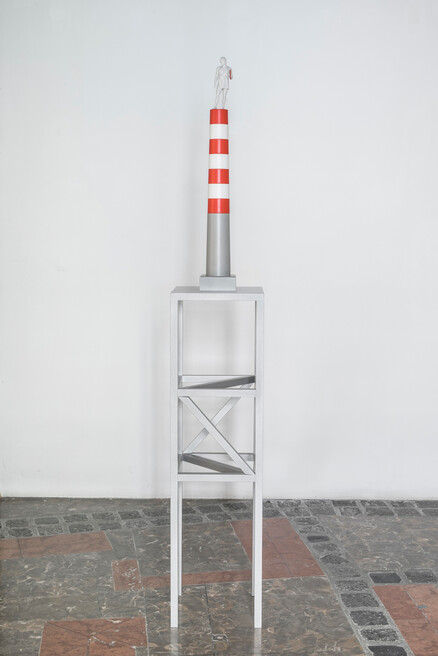Kitti Gosztola
Bereich: Bildende Kunst
Key Facts
Nationalität
UngarnBereich
Bildende KunstWohnort
BudapestEmpfehlende Institution
tranzit.org / ERSTE StiftungZeitraum
September 2020 - Oktober 2020Kitti Gosztola mainly focuses on the aesthetic and social dimensions of the construction and politics of natural sciences. Her works range from tackling craftsmanship and materialities through works based on archival research to projects focusing on socio-political issues – from reinterpreting the cow appendix membranes once used in Zeppelins through reevaluating invasive species with participants outside the artworld to a long-running investigation into Hungary’s marine imaginations.
Born 1986 in Székesfehérvár (HU)
Lives and works in Budapest (HU)
EDUCATION
2014-2017 Hungarian University of Fine Arts, Doctoral Programme, Budapest (HU)
2007-2012 Hungarian University of Fine Arts, Painting Department, Budapest (HU)
SELECTED AWARDS AND GRANTS
2019 Esterházy Art Award shortlisted, Budapest (HU)
2019 Ivan Juritz Prize listed, London (UK)
2019 Derkovits Scholarship (HU)
2018 Derkovits Scholarship (HU)
2017 Smohay Prize, King St. Stephen Museum, Székesfehérvár (HU)
2017 Klára Herczeg Prize, Studio of Young Artists’ Association (SYAA), Budapest (HU)
2013 Essl Art Award CEE shortlisted, Budapest (HU)
ARTIST IN RESIDENCE
2020 Krinzinger Projekte AIR program, Petőmihályfa (HU)
2019 Brno Artists in Residence, The House of Arts, Brno (CZ)
2019 The Morning Boat Residency, Jersey (JE)
2019 Reaktor Residency, Nová Cvernovka, Bratislava (SK)
2019 Budapest Gallery AIR program /Atelier Künstlerhaus, Salzburg (AT)
2017 Kamov Residency, Rijeka (HR)
2013 MoKS Artists Residency, Mooste (EST)
MEMBERSHIP
2008- Studio of Young Artists’ Association (SYAA), Budapest (HU)
SELECTED EXHIBITIONS
2020
Art and Game, MANK Gallery, Szentendre (HU)
2019
Short List Esterházy Art Award, Ludwig Museum, Budapest (HU)
Web of Wet, Trafó Gallery, Budapest (HU)
Upon Us All Equally, Sala Omnia, Bucharest (RO)
Flashforward, Kisterem, Budapest (solo) (HU)
Conditio Inhumana, Hungarian National Gallery, Budapest (HU)
2018
Ruminatio, King St. Stephen Museum, Székesfehérvár (solo) (HU)
Listing VII, Kisterem, Budapest (HU)
Traveling with Blind Map, Kisterem, Budapest (HU)
City vs. Nature, Deák17 Gallery, Budapest (HU)
Found exhibition - Gulliver’s remembrance, Artpool P60 Gallery, Budapest (HU)
2017
Alloy, Contemporary Art Institute, Dunaújváros (HU)
Xtro realm, Studio Gallery, Budapest (HU)
The Flying Kayak, OFF-Biennale Budapest, MTA Konkoly Observatory, Budapest (HU)
Grain of Salt, SKC Gallery, Rijeka (HR)
Listing VI, Kisterem, Budapest (HU)
2016
Botanics and Politics, Kisterem, Budapest (HU)
#Bartók, Ludwig Museum, Budapest (HU)
On the Edge, Tabacka Gallery, Košice (SK)
Accumulator, Budapest Gallery, Budapest (HU)
2015
Everybody has a dream/ everybody has a mistake, Miskolc Gallery, Miskolc (HU)
Artifcial Landscapes, Latarka Gallery, Polish Institute, Budapest (HU)
Syntopia, OFF-Biennale, Dover Language Center, Budapest (HU)
Change is Rare, AmA Ház, Budapest (HU)
2014
Anthropoflora, Studio Gallery, Budapest (HU)
On Paper, Deák Erika Gallery, Budapest (HU)
Right Tree Right Place II, Liget Gallery, Budapest (solo) (HU)
Natural Studies, Faur Zsófia Gallery, Budapest (HU)
2013
Liget 30, Olof Palme House, Budapest (HU)
Nominees’ Night (ESSL AWARD), Hungarian House of Photography, Budapest (HU)
One of my main focuses is the politics and strategies of nationalism in nature and natural sciences. This includes a long-running investigation (as part of the trio, prokaryote precariat, with Olivér Horváth and Szilvi Német) into Hungary’s marine imaginations, related to the era and memory of Fiume/Rijeka being Hungary’s port town. During my stay in Vienna, I plan to examine how the Adriatic Sea was represented from the Austrian point of view during the Austro-Hungarian monarchy to compare it with Hungarian marine aspirations. Vienna has significant resources on the subject. For example the Austrian National Library holds many documents of the 1913 Adria-Ausstellung which was a theme park in Vienna recreating the atmosphere of the Adriatic with artificial lakes making the illusion of a harbour, a marine cinema and ’copies’ of coastal village houses to promote cultural and economic relations with the Adriatic coast. The other Austrian thread related to marine life which I want to deal with is the art of Eugen von Ransonnet-Villez, an underwater painter (whose periscope was also on display at the Adriatic Exhibition). A significant part of his heritage – numerous paintings and his special diving bell – is preserved by the Museum of Natural History in Vienna, which I also want to explore for my future plans.
The aim of the open call of tranzit.org / ERSTE Stiftung was to provide opportunity for artists “to take a break from production pressure” and provide space for them to think. For artists like me who mostly create research-based works, it was a refreshing opportunity.
According to my project plan, I researched the documents of how the Adriatic Sea was represented from the Austrian point of view in the Austro-Hungarian Empire to compare it with Hungarian marine aspirations.The exhibition catalogue of the “Österreichische Riviera” organised by the Wien Museum in 2013 and the documentation of the related lectures provided a good starting point to learn more about the the political, infrastructural and economical endeavors. In my research on the related subject matters, the articles of Stefanie Jovanovic-Kruspel, the staff scientist of the Kunsthistorisches Museum Wien, served as a theoretical framework.
In addition to the research, I also tried to build professional relationships. I attended viennacontemporary, thanks to the partnership of Kisterem – by whom I am represented – and Krinzinger Projekte I could meet with Ursula Kirinzinger and Manfred Wiplinger. I further became acquainted with such inspiring Viennese curators like Barbara Horváth and Katalin Erdődy.
Several exhibitions I have seen have influenced me, such as the “Fragile Schöpfung” by Dom Museum. It was a particularly useful experience because since I returned home I have been dealing with the natural history collection of the Benedictine Archabbey of Pannonhalma, a group exhibition that will open next spring. It was great to see an example of how contemporary art communicates with sacred objects.






